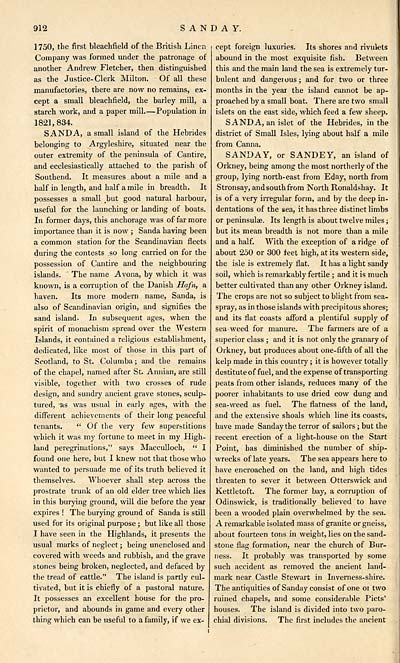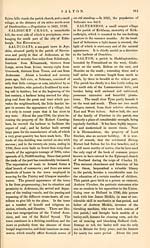Gazetteer of Scotland > Volume 2
(432) Page 912
Download files
Complete book:
Individual page:
Thumbnail gallery: Grid view | List view

912
SANDAY.
1 750, the first bleachfield of the British Linen
Company was formed under the patronage of
another Andrew Fletcher, then distinguished
as the Justice- Clerk Milton. Of all these
manufactories, there are now no remains, ex-
cept a small bleachfield, the barley mill, a
starch work, and a paper mill. — Population in
1821,834.
SAND A, a small island of the Hebrides
belonging to Argyleshire, situated near the
outer extremity of the peninsula of Cantire,
and ecclesiastically attached to the parish of
Southend. It measures about a mile and a
half in length, and half a mile in breadth. It
possesses a small but good natural harbour,
useful for the launching or landing of boats.
In former days, this anchorage was of far more
importance than it is now ; Sanda having been
a common station for the Scandinavian fleets
during the contests so long carried on for the
possession of Cantire and the neighbouring
islands. The name Avona, by which it was
known, is a corruption of the Danish Hqfn, a
haven. Its more modern name, Sanda, is
also of Scandinavian origin, and signifies the
sand island. In subsequent ages, when the
spirit of monachism spread over the Western
Islands, it contained a religious establishment,
dedicated, like most of those in this part of
Scotland, to St. Cohimba; and the remains
of the chapel, named after St Annian, are still
visible, together with two crosses of rude
design, and sundry ancient grave stones, sculp-
tured, as was usual in early ages, with the
different achievements of their long peaceful
tenants. " Of the very few superstitions
which it was my fortune to meet in my High-
land peregrinations," says Macculloch, " I
found one here, but I knew not that those who
wanted to persuade me of its truth believed it
themselves. Whoever shall step across the
prostrate trunk of an old elder tree which lies
in this burying ground, will die before the year
expires ! The burying ground of Sanda is still
used for its original purpose ; but like all those
I have seen in the Highlands, it presents the
usual marks of neglect ; being unenclosed and
covered with weeds and rubbish, and the grave
stones being broken, neglected, and defaced by
the tread of cattle." The island is partly cul-
tivated, but it is chiefly of a pastoral nature.
It possesses an excellent house for the pro-
prietor, and abounds in game and every other
thing which can be useful to a family, if we ex-
cept foreign luxuries. Its shores and rivulets
abound in the most exquisite fish. Between
this and the main land the sea is extremely tur-
bulent and dangeious; and for two or three
months in the year the island cannot be ap-
proached by a small boat. There are two small
islets on the east side, which feed a few sheep.
SANDA, an islet of the Hebrides, in the
district of Small Isles, lying about half a mile
from Canna.
SANDAY, or SANDEY, an island of
Orkney, being among the most northerly of the
group, lying north-east from Eday, north from
Stronsay, and south from North Ronaldshay. It
is of a very irregular form, and by the deep in-
dentations of the sea, it has three distinct limbs
or peninsulae. Its length is about twelve miles ;
but its mean breadth is not more than a mile
and a half. With the exception of a ridge of
about 250 or 300 feet high, at its western side,
the isle is extremely flat. It has a light sandy
soil, which is remarkably fertile ; and it is much
better cultivated than any other Orkney island.
The crops are not so subject to blight from sea-
spray, as in those islands with precipitous shores;
and its flat coasts afford a plentiful supply of
sea-weed for manure. The farmers are of a
superior class ; and it is not only the granary of
Orkney, but produces about one-fifth of all the
kelp made in this country ; it is however totally
destitute of fuel, and the expense of transporting
peats from other islands, reduces many of the
poorer inhabitants to use dried cow dung and
sea-weed as fuel. The flatness of the land,
and the extensive shoals which line its coasts,
have made Sanday the terror of sailors ; but the
recent erection of a light-house on the Start
Point, has diminished the number of ship-
wrecks of late years. The sea appears here to
have encroached on the land, and high tides
threaten to sever it between Otterswick and
Kettletoft. The former bay, a corruption of
Odinswick, is traditionally believed to have
been a wooded plain overwhelmed by the sea.
A remarkable isolated mass of granite or gneiss,
about fourteen tons in weight, lies on the sand-
stone flag formation, near the church of Bur-
ness. It probably was transported by some
such accident as removed the ancient land-
mark near Castle Stewart in Inverness-shire.
The antiquities of Sanday consist of one oi two
ruined chapels, and some considerable Picts'
houses. The island is divided into two paro-
chial divisions. The first includes the ancient
SANDAY.
1 750, the first bleachfield of the British Linen
Company was formed under the patronage of
another Andrew Fletcher, then distinguished
as the Justice- Clerk Milton. Of all these
manufactories, there are now no remains, ex-
cept a small bleachfield, the barley mill, a
starch work, and a paper mill. — Population in
1821,834.
SAND A, a small island of the Hebrides
belonging to Argyleshire, situated near the
outer extremity of the peninsula of Cantire,
and ecclesiastically attached to the parish of
Southend. It measures about a mile and a
half in length, and half a mile in breadth. It
possesses a small but good natural harbour,
useful for the launching or landing of boats.
In former days, this anchorage was of far more
importance than it is now ; Sanda having been
a common station for the Scandinavian fleets
during the contests so long carried on for the
possession of Cantire and the neighbouring
islands. The name Avona, by which it was
known, is a corruption of the Danish Hqfn, a
haven. Its more modern name, Sanda, is
also of Scandinavian origin, and signifies the
sand island. In subsequent ages, when the
spirit of monachism spread over the Western
Islands, it contained a religious establishment,
dedicated, like most of those in this part of
Scotland, to St. Cohimba; and the remains
of the chapel, named after St Annian, are still
visible, together with two crosses of rude
design, and sundry ancient grave stones, sculp-
tured, as was usual in early ages, with the
different achievements of their long peaceful
tenants. " Of the very few superstitions
which it was my fortune to meet in my High-
land peregrinations," says Macculloch, " I
found one here, but I knew not that those who
wanted to persuade me of its truth believed it
themselves. Whoever shall step across the
prostrate trunk of an old elder tree which lies
in this burying ground, will die before the year
expires ! The burying ground of Sanda is still
used for its original purpose ; but like all those
I have seen in the Highlands, it presents the
usual marks of neglect ; being unenclosed and
covered with weeds and rubbish, and the grave
stones being broken, neglected, and defaced by
the tread of cattle." The island is partly cul-
tivated, but it is chiefly of a pastoral nature.
It possesses an excellent house for the pro-
prietor, and abounds in game and every other
thing which can be useful to a family, if we ex-
cept foreign luxuries. Its shores and rivulets
abound in the most exquisite fish. Between
this and the main land the sea is extremely tur-
bulent and dangeious; and for two or three
months in the year the island cannot be ap-
proached by a small boat. There are two small
islets on the east side, which feed a few sheep.
SANDA, an islet of the Hebrides, in the
district of Small Isles, lying about half a mile
from Canna.
SANDAY, or SANDEY, an island of
Orkney, being among the most northerly of the
group, lying north-east from Eday, north from
Stronsay, and south from North Ronaldshay. It
is of a very irregular form, and by the deep in-
dentations of the sea, it has three distinct limbs
or peninsulae. Its length is about twelve miles ;
but its mean breadth is not more than a mile
and a half. With the exception of a ridge of
about 250 or 300 feet high, at its western side,
the isle is extremely flat. It has a light sandy
soil, which is remarkably fertile ; and it is much
better cultivated than any other Orkney island.
The crops are not so subject to blight from sea-
spray, as in those islands with precipitous shores;
and its flat coasts afford a plentiful supply of
sea-weed for manure. The farmers are of a
superior class ; and it is not only the granary of
Orkney, but produces about one-fifth of all the
kelp made in this country ; it is however totally
destitute of fuel, and the expense of transporting
peats from other islands, reduces many of the
poorer inhabitants to use dried cow dung and
sea-weed as fuel. The flatness of the land,
and the extensive shoals which line its coasts,
have made Sanday the terror of sailors ; but the
recent erection of a light-house on the Start
Point, has diminished the number of ship-
wrecks of late years. The sea appears here to
have encroached on the land, and high tides
threaten to sever it between Otterswick and
Kettletoft. The former bay, a corruption of
Odinswick, is traditionally believed to have
been a wooded plain overwhelmed by the sea.
A remarkable isolated mass of granite or gneiss,
about fourteen tons in weight, lies on the sand-
stone flag formation, near the church of Bur-
ness. It probably was transported by some
such accident as removed the ancient land-
mark near Castle Stewart in Inverness-shire.
The antiquities of Sanday consist of one oi two
ruined chapels, and some considerable Picts'
houses. The island is divided into two paro-
chial divisions. The first includes the ancient
Set display mode to: Large image | Transcription
Images and transcriptions on this page, including medium image downloads, may be used under the Creative Commons Attribution 4.0 International Licence unless otherwise stated. ![]()
| Gazetteers of Scotland, 1803-1901 > Gazetteer of Scotland > Volume 2 > (432) Page 912 |
|---|
| Permanent URL | https://digital.nls.uk/97436006 |
|---|
| Description | Volume II: Glenbanchor to Zetland. |
|---|---|
| Attribution and copyright: |
|
| Description | By Robert Chambers and William Chambers. Glasgow: Blackie & Son, 1838. 2 volumes. |
|---|---|
| Shelfmark | NF.1461.g.7 |
| Additional NLS resources: | |

